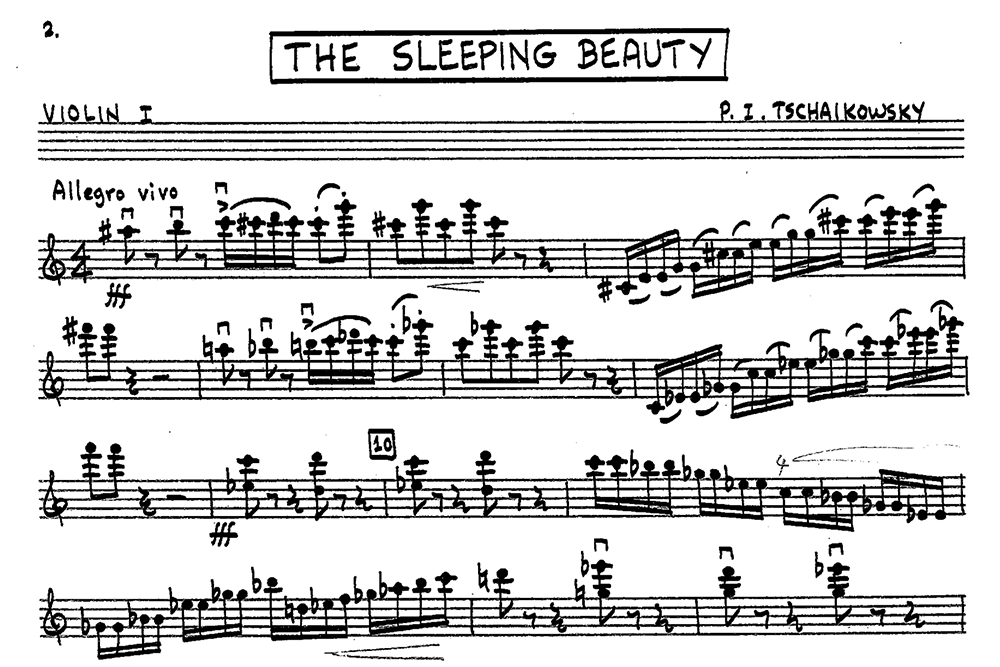Ballet
News+
The Music Library
Preparing for The Sleeping Beauty
March 1, 2022

An excerpt from the score of The Sleeping Beauty. Courtesy of the Music Library.
The National Ballet of Canada Orchestra maintains a Music Library that holds scores for all the company’s productions. In this Q&A, Raymond Tizzard, Orchestra Personnel Manager and Music Administrator, provides insights into the Music Library and what is required for The Sleeping Beauty.
How many musicians and scores are required for The Sleeping Beauty?
In total there will be 63 musicians plus our Conductor in the pit for each performance. We will have a string section of 36 players (20 violins, 6 violas, 6 cellos and 4 basses) and Tchaikovsky scored his work as follows: 2 flutes, 1 piccolo, 2 oboes, 1 English horn, 2 clarinets, 2 bassoons, 4 horns, 2 trumpets, 2 cornets, 3 trombones, 1 tuba, timpani, 3 percussionists, harp and piano.
Is Beauty the largest and longest of scores in the Music Library?
It’s not the largest score we perform – that honour goes to Prokofiev and his score for Romeo and Juliet as well as the recent scores by Joby Talbot (Alice’s Adventures in Wonderland and The Winter’s Tale). In terms of length, The Sleeping Beauty comes in just shy of 3 hours with 2 intermissions. No other show we regularly perform exceeds that.
.jpg?ext=.jpg)
Members of the Orchestra in performance at the Four Seasons Centre. Photo by Bruce Zinger.
How many scores does the Music Library hold?
Our Music Library is an amazing resource and reflects the history of the company. Over 600 works are on the shelves. Each work has scores and individual orchestral parts. We also have many piano scores as works are often rehearsed with piano accompaniment.
The Music Library has a goal to digitize its scores – how many are now available digitally now?
Over the past decade we’ve fully embraced digital technology. Close to 100 works have been scanned and exist digitally. It’s an ongoing process. Newly commissioned works always come in electronic format and we print scores on site. Music notation software is always improving.
Do members of the orchestra use paper or digital scores for practice and performances?
Members of the orchestra simply request their PDF copy to use for practice and preparation. We are even using cloud storage as a distribution format now. Players simply pull down their parts from cloud links, then upload to their iPad and place that device on their music stands. Recently more and more players are using iPads in the pit. It’s amazing how quickly musicians have adapted to new technologies. One advantage of using an iPad is that the players no longer have to lug cumbersome paper parts around. Also, turning pages is done with a foot pad in the blink of an eye. The backlighting is also very helpful and some new software applications allow a players to mark up the page with a stylus if changes or edits are required.
.jpg?ext=.jpg)
Members of the Orchestra in rehearsal at the Walter Carsen Centre. Photo by Karolina Kuras.
Will the paper scores ever disappear?
There is something very personal about the scores and parts that exist in the Music Library. One can pull out a score and see personal markings made by players and past Conductors, some of whom are no longer with us. Their stories flow from these pages… It’s a connection to the past that speaks to our ever-evolving traditions.
More About The Sleeping Beauty